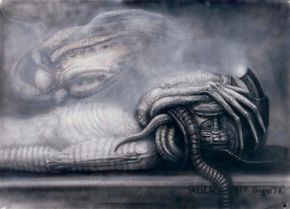The Xenomorph Facehugger
Terrestrial organisms tend to hatch from their eggs as juveniles, which are immature forms that resemble the adult, or as larvae, such as tadpoles or caterpillars, which don't. Many crustaceans even boast prelarval and postlarval forms on the long, transformative road to maturity.
Larvae are morphologically distinct from adults and undergo metamorphosis to reach full adulthood. They often feature limbs and even entire organs absent in the adult stage.
Advertisement
As such, it's no great surprise that the prelarval xenomorph differs drastically from its adult self. While a butterfly exists only to mate and breed, its larval form operates solely to eat and transform. Likewise, the fledgling xenomorph that emerges from the egg pursues a single purpose: the forced impregnation of a suitable host organism.
As we'll explore in the pages ahead, the typical adult xenomorph boasts four limbs. The prelarval xenomorph, or facehugger, however, uses eight fingerlike appendages. The crablike creature lacks anything resembling a true head -- and likewise seems to boast only the simplest of neural systems. It does, however, possess a tail similar to that of an adult. In an interesting adaptation, the creature coils this appendage like a spring to propel its body through the air to a potential host.
As the name implies, the facehugger attaches itself to a host's face and implants what can best be described as an embryo. It does this by wrapping its deceptively strong, triple-jointed legs around the victim's skull, coiling its tail around the neck and inserting a proboscis down the throat.
Once secured, the facehugger cuts off the victim's breathing and feeds just enough air down the throat to keep the host alive but unconscious. It's not attached long enough to have to supply additional sustenance.
To prevent forced removal during this vulnerable time, the facehugger tightens its grip around the victim's neck if disturbed. As the creature has concentrated acid for blood, attempts to remove it surgically often prove fatal. In a curious adaption, observers have also noted the facehugger's ability to secrete its corrosive fluids in order to penetrate helmets and armor.
With the embryo successfully implanted, the facehugger itself detaches and dies.
While most encounters with facehuggers involve human hosts, there are reports of canine, bovine and even extraterrestrial hosts as well, indicating that facehuggers attach easily to a variety of cranial and pulmonary arrangements.
Interestingly enough, however, domestic cats are universally rejected as hosts, perhaps due to size.
